Traveling the world is often seen as an expensive dream, fueled by envy-inducing social media feeds showcasing luxurious vacations. While it’s true that travel can cost a pretty penny, it doesn’t have to break the bank. Many believe that seeing the world requires emptying your savings, but the reality is, with smart planning and savvy choices, you can explore amazing destinations without spending a fortune. If you’ve ever wondered how some travelers seem to experience so much more for less, you’re in the right place. This guide will reveal the secrets to budget travel, proving that incredible adventures are within everyone’s reach.
While I wouldn’t classify myself as a hardcore budget backpacker, I am definitely a conscious traveler who seeks value without sacrificing comfort or enriching experiences. Over the years, I’ve honed strategies that consistently allow me to travel for significantly less than many of my friends, often spending a third of what they do on comparable trips. The key isn’t deprivation; it’s about making informed decisions and leveraging readily available resources to maximize your travel budget. Ready to unlock the world of affordable travel? Let’s dive into practical tips that will transform your travel aspirations into reality.
1. Master the Art of Finding Cheap Flights
Flights often represent a significant chunk of travel expenses, but they also present the most substantial opportunities for savings. The beauty of securing a cheap flight is that it’s a pure win – you get the same journey for less money, freeing up your budget for more experiences at your destination. Here are proven methods to drastically reduce your flight costs.
Utilize Powerful Flight Search Engines: Skyscanner and Google Flights
For savvy travelers, Skyscanner (Skyscanner) and Google Flights (Google Flights) are indispensable tools in the quest for cheap airfare.
Skyscanner stands out for its comprehensive inclusion of budget airlines, often overlooked by mainstream search engines. This is particularly advantageous when exploring new regions where you might be unfamiliar with local budget carriers. Its “Everywhere” search function is a game-changer for spontaneous travelers. Simply enter your departure city, select “Everywhere” as your destination, and choose your dates (or even “Whole month” for maximum flexibility). Skyscanner then displays destinations ranked by price, from the cheapest to the most expensive, perfect for finding inspiration and the best deals.
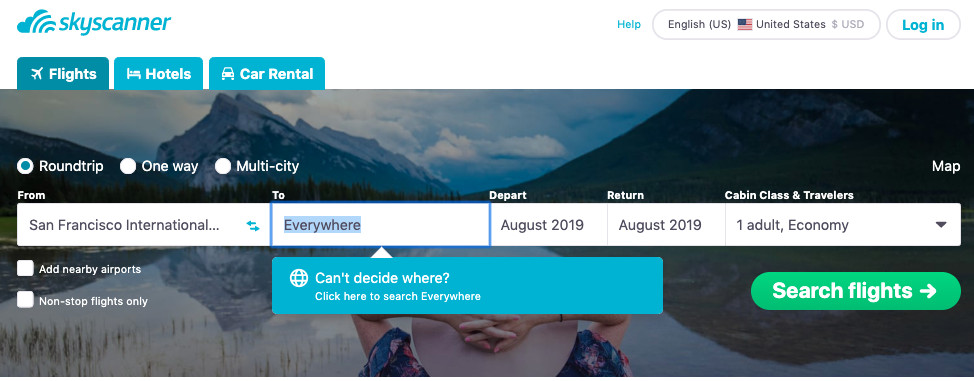 how to travel cheaper with skyscanner
how to travel cheaper with skyscanner
Alt text: Skyscanner search engine interface showing the “Everywhere” destination option, ideal for finding the cheapest flights to anywhere in the world for budget travel.
Google Flights, while newer to the scene, has rapidly become a favorite among frequent flyers due to its robust features and user-friendly interface. Its strength lies in its advanced search capabilities, allowing you to simultaneously track fares for multiple departure and arrival cities – a significant advantage over limiting searches to single cities or “nearby airports”. The filtering options are extensive, letting you refine searches by specific airlines, layover airports, baggage allowance, and more, ensuring you pinpoint flights that perfectly match your needs.
The “Date Grid” feature is visually intuitive, displaying a calendar view of fares for surrounding dates, enabling you to easily identify the cheapest days to fly. Crucially, Google Flights’ “Track Prices” feature keeps you informed of fare fluctuations via email alerts. Once you’ve set your desired route and filters, activating price tracking ensures you never miss out on a price drop, empowering you to book at the optimal moment.
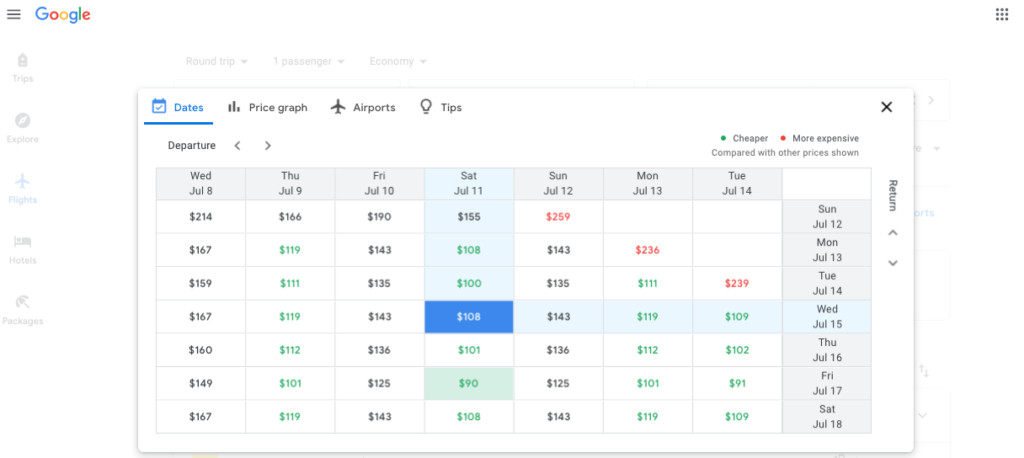 Google flights price grid
Google flights price grid
Alt text: Google Flights Date Grid feature displaying flight prices across a calendar, highlighting cheaper dates for flexible and budget-conscious travelers.
Leverage Mobile Apps: Hopper for Price Prediction
Hopper (iPhone or Android) is a mobile-first app designed to simplify flight and hotel booking with a focus on price prediction. Its core functionality revolves around monitoring flight routes you select and sending notifications when prices decrease. Hopper’s predictive algorithms analyze historical price data to forecast future price trends, advising you whether to book now or wait for a potential dip. It also alerts you to deals on flights to nearby airports, broadening your options for cheaper travel. You can track multiple routes simultaneously, keeping an eye on various potential trips. While Hopper also offers hotel booking services, its flight price prediction is its standout feature for budget travelers.
 Hopper mobile app welcome page
Hopper mobile app welcome page
Alt text: Hopper app welcome screen on a mobile phone, showcasing its flight and hotel booking interface for finding budget travel deals.
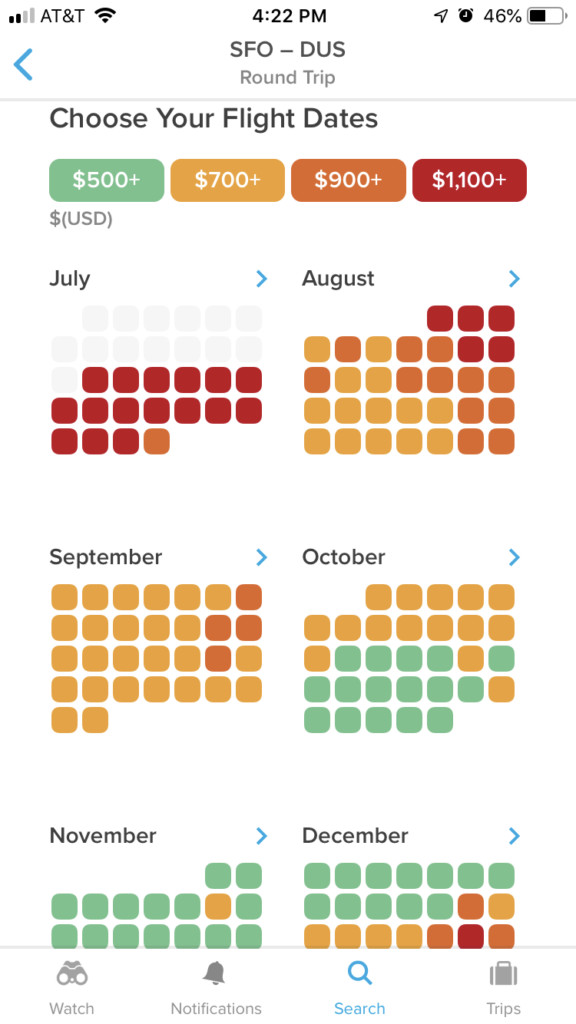 how to travel cheaper with hopper mobile app
how to travel cheaper with hopper mobile app
Alt text: Hopper app displaying flight price predictions and recommendations, helping users decide when to book for the cheapest airfare on mobile.
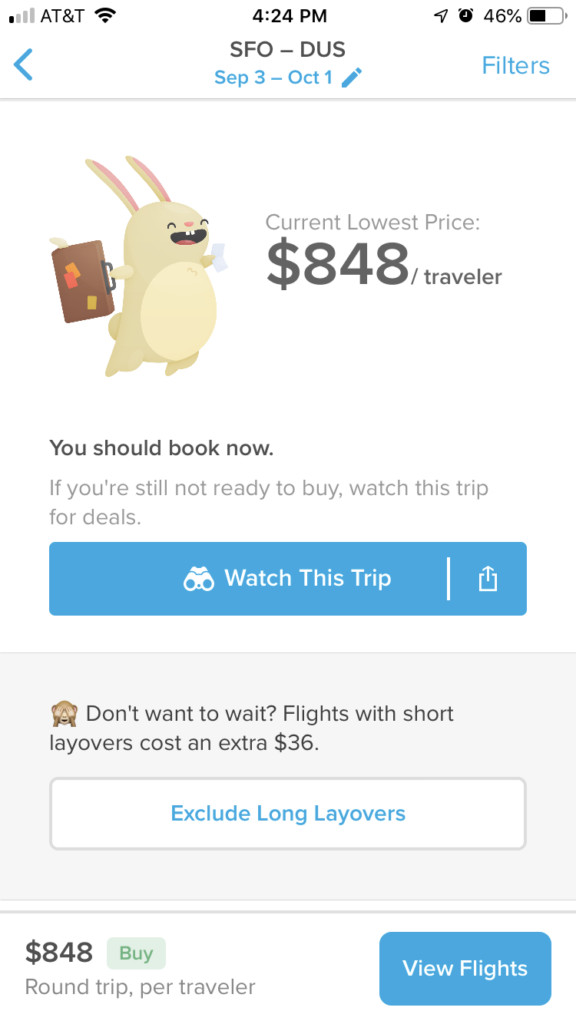 how to travel cheaper with hopper mobile app
how to travel cheaper with hopper mobile app
Alt text: Hopper app showing flight price drop notification, alerting users to potential savings on tracked routes for budget-conscious travel planning.
 how to travel cheaper with hopper mobile app
how to travel cheaper with hopper mobile app
Alt text: Hopper app interface illustrating flight monitoring and tracking features, enabling users to stay updated on price changes and find cheap travel options via mobile.
Subscribe to Scott’s Cheap Flights (Now Going) for Mistake Fares and Deep Discounts
For serious flight deal hunters, Scott’s Cheap Flights (now rebranded as Going) (Scott’s Cheap Flights) is an invaluable resource. This email subscription service alerts you to exceptional flight deals, including mistake fares and significant price drops, often on major airlines. These deals are time-sensitive, typically lasting only 24-48 hours, requiring quick action if you spot a desirable fare. Going operates on a freemium model, offering both free and paid subscriptions. The free version provides a solid stream of deal alerts, usually once or twice daily, while the premium version offers more frequent alerts, including access to even deeper discounts and mistake fares, making it a worthwhile investment for frequent travelers seeking maximum savings on flights.
Embrace Budget Airlines, but Read the Fine Print
Budget airlines are a cornerstone of cheap travel, particularly within Europe, Asia, and Latin America. Airlines like RyanAir, EasyJet, Vueling, and EuroWings in Europe, and numerous equivalents in other regions, offer dramatically reduced fares by unbundling services traditionally included in standard airline tickets. While these airlines can unlock incredibly affordable travel, it’s crucial to meticulously review the terms and conditions before booking. Budget airlines often charge extra for everything from checked baggage and seat selection to onboard meals and even airport check-in. Familiarize yourself with their baggage restrictions (often stricter and smaller than major airlines’ carry-on allowances) and fees for extras to avoid unexpected costs that can negate the initial savings. Traveling carry-on only is often essential with budget airlines to truly maximize savings.
Consider Carry-On Only Travel
Traveling with only a carry-on bag is a strategic move for budget travelers, aligning perfectly with the restrictions and fees of budget airlines. Even major airlines are increasingly adopting “basic economy” fares that restrict checked baggage allowance on international routes. Beyond avoiding baggage fees, carry-on only travel streamlines your journey, saving time at check-in and baggage claim, and reducing the risk of lost luggage. Packing light requires careful planning and versatile clothing choices, but numerous resources are available to guide you, such as guides specifically dedicated to carry-on only travel, which offer packing lists, capsule wardrobe ideas, and space-saving techniques.
2. Secure Budget-Friendly Accommodation
After flights, accommodation usually constitutes the next largest travel expense. However, just like flights, smart choices can significantly cut down your lodging costs without compromising safety, cleanliness, or convenient location – the three non-negotiable factors for budget-conscious yet comfortable travelers.
Explore Airbnb for Local and Affordable Stays
Airbnb (AirBnB) has revolutionized travel accommodation, offering a vast marketplace of apartments, houses, villas, and unique stays directly from local hosts. Airbnb often presents substantial savings compared to hotels, especially for groups or families, as you’re renting an entire space rather than individual hotel rooms. Beyond cost savings, Airbnb frequently provides a more authentic and localized experience, often situated in residential neighborhoods rather than tourist-heavy hotel districts. Many Airbnb listings come equipped with kitchens and laundry facilities, further reducing dining and laundry expenses on longer trips. If you are new to Airbnb, referral links can often provide discounts on your first booking, incentivizing you to try this budget-friendly accommodation option.
 airbnb travel booking website
airbnb travel booking website
Alt text: Airbnb website interface showing search results for vacation rentals, highlighting diverse and budget-friendly accommodation options for travelers.
Embrace Hostels for Sociable and Economical Lodging
Hostels, while sometimes carrying outdated stereotypes, are a fantastic option for budget travelers, particularly solo adventurers and those seeking a social atmosphere. Modern hostels offer a range of room types, from dormitories (mixed or single-sex) to private rooms, catering to different comfort levels and budgets. Dorm beds are significantly cheaper than hotel rooms, often costing under $30 per night in major European cities and even less in regions like Southeast Asia and South America. Hostels foster a communal environment, making them ideal for meeting fellow travelers. Many hostels organize social events, walking tours, and activities, providing opportunities to connect with others and explore the destination together. A significant money-saving perk of hostels is their communal kitchens, allowing you to prepare your own meals using locally sourced ingredients, cutting down on restaurant costs. Websites like Booking.com (Booking) and Hostelworld (HostelWorld) are excellent platforms for finding and booking hostels, offering reviews, photos, and location information to help you choose the best option for your needs. Booking platforms often offer loyalty programs or discounts for frequent users, further enhancing savings.
Consider Couchsurfing or Housesitting for Free Accommodation
For the most adventurous budget travelers, Couchsurfing (Couch Surfing) and housesitting present opportunities for free accommodation. Couchsurfing connects travelers with local hosts who offer free lodging, often on a couch or spare room, driven by cultural exchange and meeting new people. Housesitting involves staying in someone’s home for free while they are away, typically caring for their pets and property. Housesitting assignments can range from a few days to several months, offering a prolonged period of free accommodation in exchange for responsible house and pet care. While these options can dramatically reduce accommodation costs, they require flexibility, trustworthiness, and a willingness to engage in cultural exchange or pet care responsibilities. Safety is paramount, especially for solo female travelers, requiring careful vetting of hosts or housesitting opportunities.
Book Accommodation in Advance for Best Deals
Unlike flights, last-minute deals on desirable accommodation are rare. The best strategy for securing budget-friendly and well-located lodging is to book as far in advance as possible. The most affordable and highly-rated hostels, guesthouses, and budget hotels tend to sell out quickly, especially during peak season. Booking early ensures you have a wider selection of options and aren’t limited to more expensive or less conveniently located remaining choices. Advance booking is particularly crucial for popular destinations or during major events and holidays when demand surges and prices escalate.
3. Choose Budget-Friendly Destinations and Travel Seasons
One of the most impactful ways to travel cheap is to strategically select destinations and travel during off-peak seasons.
Opt for Destinations with Lower Costs of Living
Choosing destinations with weaker currencies or lower costs of living compared to your home country can drastically reduce your overall travel expenses. Consider countries within Europe that are outside the Eurozone, such as Eastern European nations, where prices for food, accommodation, and transportation are significantly lower than in Western Europe. Entire regions like Southeast Asia, South America, and parts of Africa offer incredibly affordable travel experiences, where your daily expenses can be a fraction of what you’d spend in North America or Western Europe. Even within generally expensive regions, choosing less touristy countries or cities can lead to substantial savings. For example, consider Portugal as an alternative to Spain, or smaller Eastern European cities instead of capital cities. Longer trips to budget-friendly destinations can be particularly cost-effective, as the low daily expenses accumulate significant savings over time, offsetting potentially higher flight costs.
Travel During the Off-Season or Shoulder Season
If your heart is set on a popular or typically expensive destination, traveling during the off-season or shoulder season can unlock significant savings. Off-season travel, typically during the least popular tourist months, can mean dramatically lower prices for flights and accommodation. For example, visiting Europe in winter or shoulder seasons (spring and fall) often yields substantial discounts. Traveling to Iceland in winter, for instance, can result in savings of hundreds of dollars on campervan rentals and lower flight costs compared to peak summer months. However, off-season travel may come with trade-offs, such as less favorable weather or closures of some attractions. Shoulder season travel, occurring just before and after peak season, often provides a sweet spot, offering pleasant weather, fewer crowds, and reduced prices compared to peak season. Traveling to Croatia in May or September, for example, can mean enjoying warm weather and lower prices on attractions compared to the peak summer months of July and August.
4. Avoid Bank Fees: Embrace Fee-Free Banking
Foreign transaction fees and ATM withdrawal charges can erode your travel budget without you even realizing it. Most traditional credit cards and debit cards levy foreign transaction fees, typically around 3% of every purchase made abroad. Debit cards often compound these fees with per-withdrawal charges at foreign ATMs, sometimes as high as $5 per transaction. These fees may seem small individually, but they accumulate rapidly, especially on longer trips or in cash-based economies.
Before traveling, research and consider opening a travel rewards credit card and a checking account with institutions that waive foreign transaction fees and ATM fees. Numerous credit cards are specifically designed for travelers, offering zero foreign transaction fees, travel rewards points, and other perks like travel insurance or airport lounge access. For debit card access to cash abroad, consider opening a checking account with banks like Charles Schwab or Capital One 360, which are known for reimbursing ATM fees worldwide and not charging foreign transaction fees, providing cost-effective access to your funds while traveling internationally.
5. Save Up Gradually and Strategically
While these tips focus on reducing travel expenses, remember that travel still requires a financial investment. However, saving for your adventures doesn’t have to be daunting. Small, consistent savings habits can accumulate significantly over time.
Cut Back on Daily Expenses: The Coffee Example
Consider small daily expenses that add up over time. A daily $5 coffee, for instance, might seem insignificant, but over a week, it totals $35, and over a month, $140. Over a year, that’s $1680 – potentially enough for a round-trip flight to Europe or several weeks of budget travel in Southeast Asia. Making coffee at home, even a few times a week, can free up a surprising amount of money for your travel fund.
Reduce Dining Out Frequency: Cook More Meals
Dining out is a significant budget drain, especially in many Western countries. The convenience of brunch with friends or takeout meals after work comes at a cost. Even just one brunch per week at $25 can amount to over $100 per month. Cooking more meals at home is significantly cheaper and often healthier. Meal prepping on weekends ensures you have readily available and affordable meals throughout the week, reducing the temptation for expensive takeout or restaurant dining. While traveling, you’ll likely be eating out more, so cutting back on restaurant meals at home can be a strategic way to save for your trip.
Start Saving Early and Consistently: Time is Your Ally
The most effective way to save for travel is to start early and save consistently over time. Small, regular savings contributions are less noticeable than drastic budget cuts and accumulate steadily. Saving $50 per week, for example, amounts to $2600 in a year, a substantial travel fund. Automating savings transfers from your checking account to a dedicated savings account each week or month makes saving effortless and consistent. The longer you save, the more you accumulate, and the more achievable your travel goals become. As the saying goes, the best time to start saving was yesterday, the next best time is now.
Your Budget Travel Journey Begins Now
Don’t let the perception of high costs deter you from exploring the world. Travel doesn’t have to be synonymous with exorbitant spending. By implementing these strategies – from mastering cheap flight searches and budget accommodation to choosing affordable destinations and adopting smart saving habits – you can unlock incredible travel experiences without breaking the bank.
What are your favorite budget travel tips? Share your wisdom in the comments below!
Pin it for Later!
 Traveling on a budget? I go into detail on specific ways I travel cheap, without giving up much.
Traveling on a budget? I go into detail on specific ways I travel cheap, without giving up much.
Alt text: Pinterest pin image promoting budget travel guide, text overlay reads “Travel Cheaper: Your Guide to Affordable Adventures”.
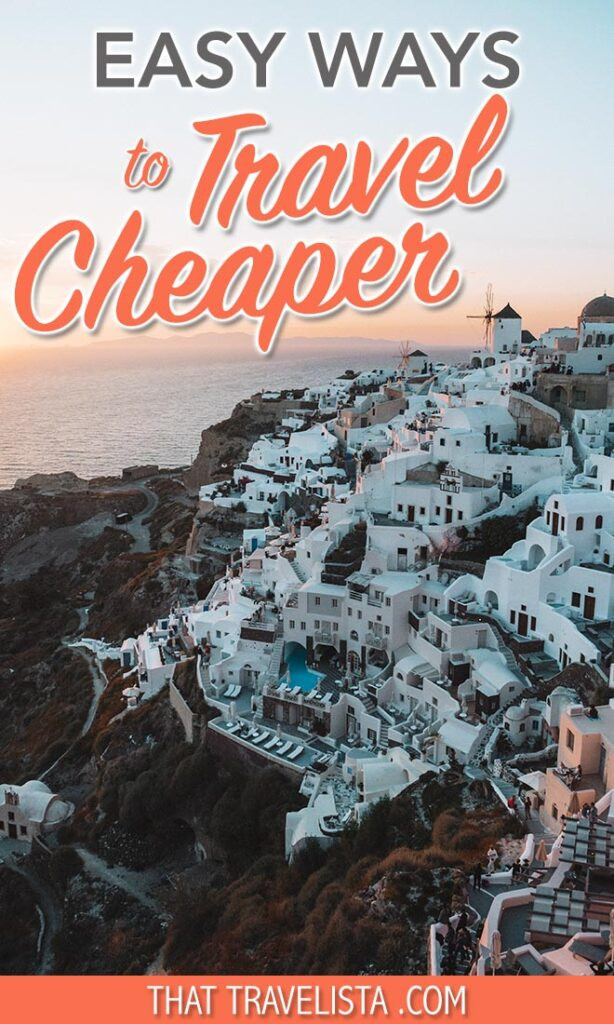 Traveling on a budget? I go into detail on specific ways I travel cheap, without giving up much.
Traveling on a budget? I go into detail on specific ways I travel cheap, without giving up much.
Alt text: Vertical Pinterest pin graphic for budget travel tips, text overlay reading “Ultimate Guide: How to Travel Cheap and See the World”.
 Traveling on a budget? I go into detail on specific ways I travel cheap, without giving up much.
Traveling on a budget? I go into detail on specific ways I travel cheap, without giving up much.
Alt text: Pinterest sharing image for cheap travel advice, text states “Budget Travel Secrets: Explore the World Without Breaking the Bank”.
